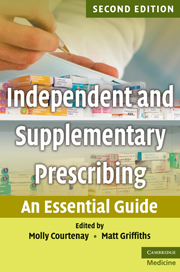Book contents
- Frontmatter
- Contents
- List of contributors
- Foreword to the second edition
- Preface to the second edition
- 1 Non-medical prescribing: an overview
- 2 Non-medical prescribing in a multidisciplinary team context
- 3 Consultation skills and decision making
- 4 Legal aspects of independent and supplementary prescribing
- 5 Ethical issues in independent and supplementary prescribing
- 6 Psychology and sociology of prescribing
- 7 Applied pharmacology
- 8 Monitoring skills
- 9 Promoting concordance in prescribing interactions
- 10 Evidence-based prescribing
- 11 Extended/supplementary prescribing: a public health perspective
- 12 Calculation skills
- 13 Prescribing in practice: how it works
- 14 Minimising the risk of prescribing error
- Index
- References
1 - Non-medical prescribing: an overview
Published online by Cambridge University Press: 10 January 2011
- Frontmatter
- Contents
- List of contributors
- Foreword to the second edition
- Preface to the second edition
- 1 Non-medical prescribing: an overview
- 2 Non-medical prescribing in a multidisciplinary team context
- 3 Consultation skills and decision making
- 4 Legal aspects of independent and supplementary prescribing
- 5 Ethical issues in independent and supplementary prescribing
- 6 Psychology and sociology of prescribing
- 7 Applied pharmacology
- 8 Monitoring skills
- 9 Promoting concordance in prescribing interactions
- 10 Evidence-based prescribing
- 11 Extended/supplementary prescribing: a public health perspective
- 12 Calculation skills
- 13 Prescribing in practice: how it works
- 14 Minimising the risk of prescribing error
- Index
- References
Summary
In 1986, recommendations were made for nurses to take on the role of prescribing. The Cumberlege report, Neighbourhood nursing: a focus for care (Department of Health and Social Security (DHSS) 1986), examined the care given to clients in their homes by district nurses (DNs) and health visitors (HVs). It was identified that some very complicated procedures had arisen around prescribing in the community and that nurses were wasting their time requesting prescriptions from the general practitioner (GP) for such items as wound dressings and ointments. The report suggested that patient care could be improved and resources used more effectively if community nurses were able to prescribe as part of their everyday nursing practice, from a limited list of items and simple agents agreed by the DHSS.
Following the publication of this report, the recommendations for prescribing and its implications were examined. An advisory group was set up by the Department of Health (DoH) to examine nurse prescribing (DoH 1989). Dr June Crown was the Chair of this group.
The following is taken from the Crown report:
Nurses in the community take a central role in caring for patients in their homes. Nurses are not, however, able to write prescriptions for the products that are needed for patient care, even when the nurse is effectively taking professional responsibility for some aspects of the management of the patient. However experienced or highly skilled in their own areas of practice, nurses must ask a doctor to write a prescription. It is well known that in practice a doctor often rubber stamps a prescribing decision taken by a nurse. […]
- Type
- Chapter
- Information
- Independent and Supplementary PrescribingAn Essential Guide, pp. 1 - 6Publisher: Cambridge University PressPrint publication year: 2010
References
- 2
- Cited by



